Exeter House and Foley House are thought to have been built as early as 1650 in the time of Charles II, and later Foley House became the main residence while Exeter House was used by the resident trainer. In the late 18th century and early years of the 19th century the properties, along with extensive gardens, were owned by Thomas Foley, the 3rd Baron Foley, who was able to make use of Foley House Stables and their original stalls. When Cecil Brownlow, the 2nd Marquess of Exeter, came of age in 1816 he spent more time and money pursuing his passion for horse racing. He purchased Exeter House and Foley House in around 1820, and developed and extended Foley House Stables, renaming them Exeter House Stables, taking full advantage of the proximity of the Houses, gardens and stables to Newmarket Heath. Exeter House Stables, not to be confused with Exeter Stables in Exning, were extended in the 1820s and were famed for their covered ride and walkway, believed to have been completed in the 1835. Entry to the stables from Exeter Road was through an archway between the rear wing of the house and the north end of the west range of the stables. The original stalls were formed into caged loose boxes at this point, with Cecil Brownlow installing William Harlock as his private trainer from 1820 until 1855.
For over 4 centuries racing has been staged in Newmarket, but how have the racecourses evolved from an initial starting point at Fleam Dyke Pumping Station, some 8 miles from the town, with a winning post barely 200 metres from the town centre, into two world recognized, excellent racecourses and a universal acceptance that Newmarket is the Headquarters of racing?
To access an interactive racecourse map showing over 50 individually named racecourses CLICK HERE. The map will enable you to:-
1. Determine when extended races over 8 miles, 6 miles and 4 miles began to be replaced by the courses now visited by thousands annually;
2. Consider how the challenge of crossing the Devil's Dyke was overcome;
3. Contemplate why the town no longer has a steeplechase course despite having at least 5 courses during the past 2 centuries;
4. Examine the practicalities of having up to 48 starting posts and winning posts;
5. Appreciate that it was not financially viable to have an open racecourse spread widely across the heath, with a finishing post barely 200 metres from the town centre;
6. Research how and why the Cambridgeshire Handicap has been contested over 3 different courses.
NOTE: The map does not make mention of 2 particular courses:-
(i) Sefton Course (also known as the Cambridge Road Course)
Source: 1970 Raceform.Used from 1959 to 1975.
(ii) New Circular Course
The Circular Handicap was run on Friday 29th October 1875 on the New Circular Course of about two miles.
Source: London Standard (30th October 1875): ''the horses started near the Turn of the Lands, ran back way of the Cambridgeshire Course towards the Ditch, and afterwards proceeded down the side of the Tan Gallop, and turned into the Rowley Mile near the Bretby Stakes starting post, finishing at the stand at the end of the flat. Except in the hollow near the Cambridgeshire start the runners should have been visible all the way if the sky had been bright and clear''.
Another report hoped that the Circular Handicap would become a feature in future programmes, as it would be contested in front of the new grandstand which would be completed in about a year and would be able to accommodate thousands.
(I am grateful to Tim Cox for bringing attention to these 2 courses.)
Enjoy researching the intriguing history of Newmarket and its many racecourses.
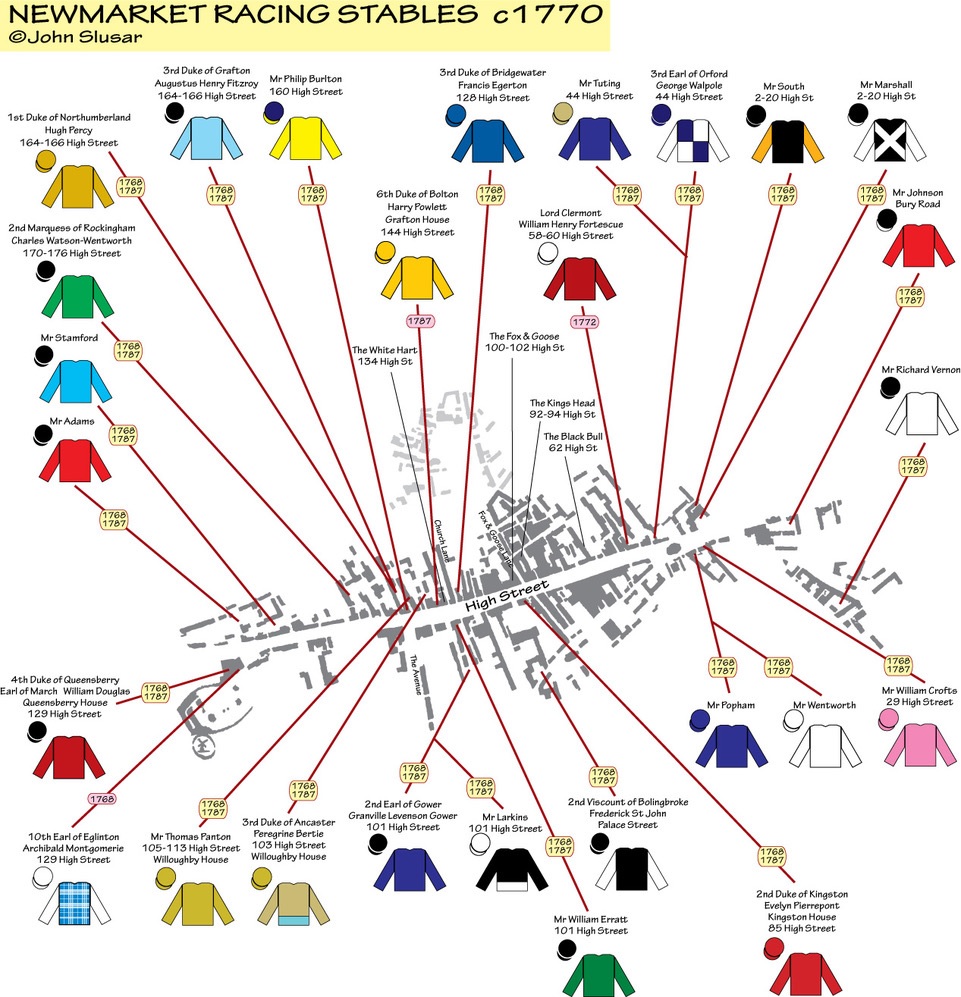
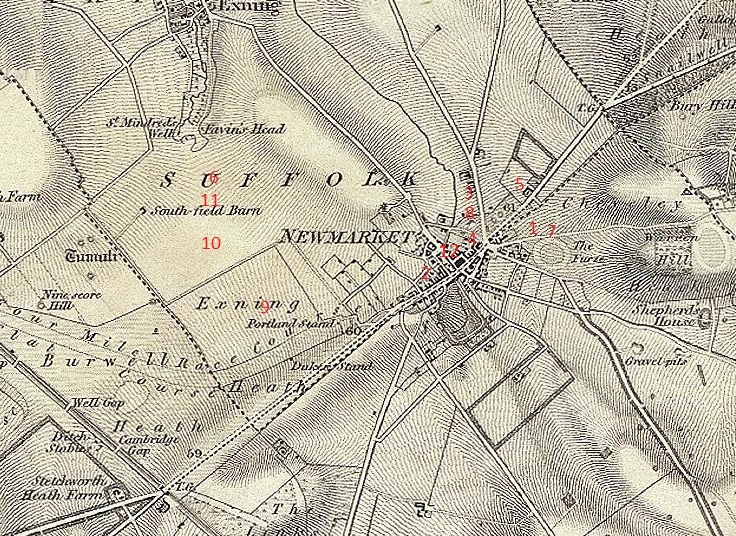
1780-1833 Thomas Foley, 3rd Baron Foley, Richard Prince
Thomas Foley, son of the 2nd Baron Foley, also named Thomas, and his wife Henrietta Stanhope, was born on 22nd December 1780 and became 3rd Baron Foley on the death of his father in 1793 when he was just 12, inheriting Foley House and Stables. He could not take his seat in the House of Lords until his coming of age in December 1801. Five years later he married Lady Cecilia Olivia Geraldine Fitzgerald on 18th August 1806, just two months after he had won the Epsom Derby with Paris (SR 1937). Between 1805 and 1806 he was made Master of the Quorn Hunt, later going on to win the 1815 1000 Guineas with his Filly by Selim (SR 1860), and the 1818 2000 Guineas with Interpreter (1972), both trained by Richard Prince. He died on 16th April 1833, but by then he had sold Foley House and Stables to Cecil Brownlow, the 2nd Marquess of Exeter.
1815 1000 Guineas FILLY BY SELIM (SR 1860) 3/1 owned by 3rd Baron Foley, trained by Richard Prince and ridden by Bill Clift
1818 2000 Guineas INTERPRETER (SR 1972) 7/4 fav owned by 3rd Baron Foley, trained by Richard Prince and ridden by Bill Clift
Daniel Dawson, Richard Prince, Lord Foley
Richard Prince senior trained for Lord Foley at Foley House/Exeter House Stables at the time of the Daniel Dawson affair. At some stage in Newmarket there were racing stables in the centre of the town, close to Heathview House, which Richard Prince used, and which were known throughout the town as Prince's Stables, which were still in existence at the start of the 20th century. It is not known whether these were used as an overflow stable by Richard Prince senior, or as a main stable. Daniel Dawson first came to prominence in 1807 as a renowned tipster in Newmarket, but his success and notoriety led to an agreement between a number of English sporting publications to cease printing advertisements of racing tipsters. Well after racing became a popular pastime in the country, tipsters began to make their appearance, and it proved to be a lucrative business, but it did enable unscrupulous tipsters to seek ways in which their selections would have a greater chance of success. However, others saw opportunities to far greater profits if their selections were unsuccessful. Daniel Dawson was illiterate, but was a shrewd judge of a race horse's ability and soon became known as a remarkable forecaster of winners. His fame spread and his tips were in great demand, leading him to make vast, legitimate profits, but he began to fall in with various educated and clever rogues. It was these new-found companions who spotted the chance to use Dawson's fame as a means of executing sensational betting coups. Dawson was encouraged to name his selections in important races many days in advance of their actual races, causing them to become favourites, which led to extended prices on the other horses. Dawson was then handed poison to give to his selections, so eliminating the chances of them winning their races, leaving his rogue friends to clean up on the other horses at longer odds than expected. This scam went on for up to 4 years until Lord Foley lost 3 of his best racehorses from his Foley House Stables at Newmarket in 1811, which led to him exposing the scam and ultimately bringing Dawson, and a confederate named Cecil Bishop, to trial at Cambridge Summer Assizes in 1812. Cecil Bishop, a chemist and drug store worker in Wardour Street, Newmarket, turned King's evidence, leaving Dawson to take full blame and its terrible consequences.
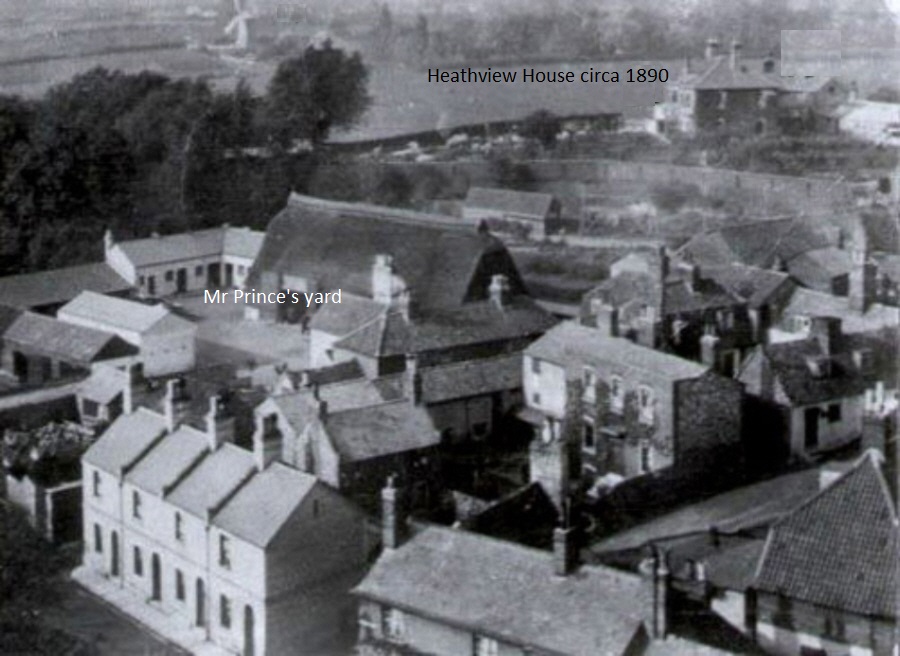
As the trial neared its end the evidence against Dawson, 48 years of age, was irrefutable, and he was found guilty. The Judge pronounced sentence of death on the prisoner, and strongly reminded the prisoner that he could not expect mercy. Immediately after his conviction Dawson was unruly and boisterous, but he was then visited in prison by the Chaplin, Reverend Pearce, who instilled in his mind the chance of redemption and forgiveness in the next world. The Reverend was greatly troubled when witnessing the final tender moments between Dawson and his wife, a respectable, upstanding woman, with Dawson expressing that his wife meant more to him than life itself. Dawson spent his final few days in prayer, while on the scaffold he was manly, and used his new-found religious fortitude to express his desire to be in a happier place shortly. He confessed his guilt of about 20 poisonings, pleading that he had never meant to kill the horses, but to stop them, although he mentioned a couple of horses, Clinker and Wizard, which he was alleged to have poisoned, but which he claimed he had not poisoned.
The sentence was carried out at 12 noon on a Saturday in Cambridge, on top of Cambridge Castle, on a market day, witnessed by at least 12,000 spectators.
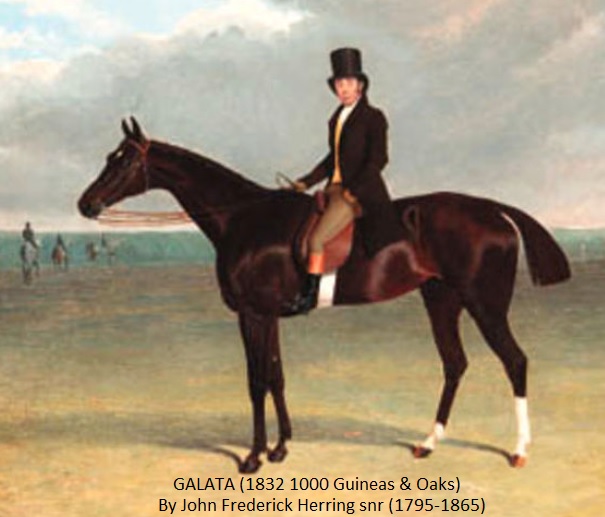
1820-1861 Cecil Brownlow, William Harlock, Charles Marson
Cecil Brownlow, 2nd Marquess of Exeter, born on 2nd July 1795, was the eldest son of Henry Cecil, 1st Marquess of Exeter and his wife Sarah (nee Hoggins). His mother died when he was just 2, while his father died when he was 8, after which he became 2nd Marquess of Exeter, although he called himself Lord Burghley until 1804. When he came of age in July 1816 he inherited vast wealth and was able to pursue his hobby of horse racing, relishing the chance to see his racing colours of light blue and white narrow stripes and black cap in the winning enclosure. He purchased Foley House and Stables shortly afterwards, renaming the Stables Exeter House Stables, undertaking a large extension and refurbishment to the stables. He made an inspired decision by putting in the first covered ride way in 1835 which provided him with the opportunity to get his horses fit for the early part of the flat season when other stables might have suffered from hard, frost ridden ground. His horses were trained in the first year by Richard Prince junior, a continuation of the agreement between Lord Foley and Richard Prince senior, followed thereafter by Charles Marson and William Harlock and, together, they provided him with 9 English Classic victories. He won the 1821 Epsom Oaks with Augusta (SR 1979) when trained by Richard Prince junior, whose father had trained for Lord Foley. In 1825 Cecil won the 2000 Guineas with Enamel (SR 1970), followed in 1829 by a dual Classic success, firstly with Patron (SR 1954) in the 2000 Guineas, followed by Green Mantle (SR 1966) in the Epsom Oaks. The next year he captured the 1830 2000 Guineas with Augustus (SR 1953), while in 1832 he owned the filly Galata (SR 1983) who won the 1000 Guineas and Oaks. However, arguably his best horse was Stockwell (SR 2063) who won the 1852 2000 Guineas and followed up in the St Leger. William Harlock remained at Foley House Stables until July 1861, after which he transferred to Graham Place. Lord Exeter died on 16th January 1867 aged 71.
1821 Epsom Oaks AUGUSTA (SR 1979) 20/11 fav owned by 2nd Marquess of Exeter, trained by Richard Prince junior and ridden by Jem Robinson
1821 Port Stakes SNAKE 3/1 owned by 2nd Marquess of Exeter, trained by Richard Prince jnr and ridden by Jem Robinson
1825 2000 Guineas ENAMEL (SR 1970) 7/4 fav owned by 2nd Marquess of Exeter, trained by Charles Marson and ridden by Jem Robinson
1829 2000 Guineas PATRON (SR 1954) 1/8 fav owned by 2nd Marquess of Exeter, trained by Charles Marson and ridden by Frank Boyce
1829 Epsom Oaks GREEN MANTLE (SR 1966) 6/1 owned by 2nd Marquess of Exeter, trained by Charles Marson and ridden by George Dockeray
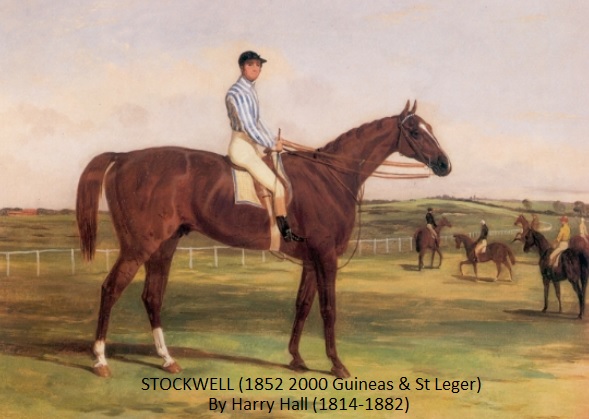
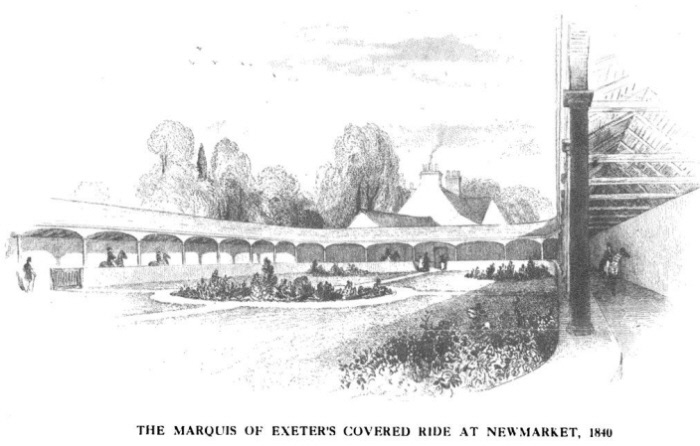
1830 Swinley Stakes GREEN MANTLE 1/3 fav owned by 2nd Marquess of Exeter, trained by Charles Marson and ridden by George Dockeray
1830 Grand Duke Michael Stakes at Newmarket AUGUSTUS 5/4 fav owned by 2nd Marquess of Exeter, trained by Charles Marson and ridden by Patrick Conolly
1830 Newmarket St Leger AUGUSTUS 2/5 fav owned by 2nd Marquess of Exeter, trained by Charles Marson and ridden by Bill Arnull
1830 Port Stakes GREEN MANTLE 3/1 owned by 2nd Marquess of Exeter, trained by Charles Marson and ridden by Patrick Conolly
1831 Newmarket Handicap Stakes AUGUSTUS 100/15 owned by 2nd Marquess of Exeter, trained by Charles Marson and ridden by Patrick Conolly
1831 Swinley Stakes AUGUSTUS 1/3 fav owned by 2nd Marquess of Exeter, trained by Charles Marson and ridden by Patrick Conolly
1832 Windsor Forest Stakes GALATA 2/5 fav owned by 2nd Marquess of Exeter, trained by Charles Marson and ridden by Patrick Conolly
1832 Epsom Oaks GALATA (SR 1983) 9/4 fav owned by 2nd Marquess of Exeter, trained by Charles Marson and ridden by Patrick Conolly
1833 Port Stakes GALATA 7/2 owned by 2nd Marquess of Exeter, trained by Charles Marson and ridden by Sam Darling
1833 Ascot Gold Cup GALATA 1/3 fav owned by 2nd Marquess of Exeter, trained by Charles Marson and ridden by Patrick Conolly
1852 2000 Guineas STOCKWELL (SR 2063) 10/1 owned by 2nd Marquess of Exeter, trained by William Harlock and ridden by John Norman
1852 Newmarket Stakes STOCKWELL 4/9 fav owned by 2nd Marquess of Exeter, trained by William Harlock and ridden by John Norman
1852 Great Yorkshire Stakes at York STOCKWELL even fav owned by 2nd Marquess of Exeter, trained by William Harlock and ridden by John Norman
1852 St Leger STOCKWELL (SR 2063) 7/4 fav owned by 2nd Marquess of Exeter, trained by William Harlock and ridden by John Norman
1857 Baron Meyer de Rothschild, William Harlock
In 1857 Baron Meyer de Rothschild made use of Exeter House stables as a stop-gap until completing his purchase of Palace House Stables later in the year. The Baron purchased Palace House Stables from The Crown in 1857 and set about improving it for the next 4 years, initially installing James 'Jem' Godding as his trainer. William Harlock remained at Foley House Stables where he trained until July 1861.
1862-1871 Zachariah Simpson Foley House
When William Harlock transferred his training establishment to Graham Place, near Birdcage Walk, Foley House, Stables and extensive grounds were taken over by Zachariah Simpson. In late 1871 the estate was advertised for sale, although it did not sell immediately, it was offered again in April 1872 and eventually sold to William Day in September 1872. The deal consisted of Foley House and adjoining brick stables with slate roofs, gardens, a carriage drive, shrubbery, lawns, domestic offices and a pair of newly built houses.
Sept 1872-1873 William Day Foley House
When William Day purchased the Foley House estate and stables in September 1872, he vowed to undertake a complete renovation of Foley House. The horses, including Nonius, began arriving at the stable in October 1872.
1874-1876 Mr C Grocock Foley House
In early 1874 C Grocock took on a 3-year lease of Foley House and stables, and he bought a good number of lots at Newmarket Craven Meeting bloodstock sale. He also kept a number of ponies which he regularly showed at Alexandra Park Horse Show.
1877 Foley House Stables W Gilbert
In 1877 Mr W Gilbert resided at Foley House Stables and in February welcomed a string of horses, sent down from Richmond, which were owned by Lord Zetland. By July 1877 Exeter House and adjoining stables, as well as 3 cottages on the estate, were offered for auction, but only the 3 cottages were sold.
February 1877 Foley House Benjamin Chennell
Charles Bottom, landlord of the White Hart, was born in Newmarket and baptised at St Mary's Church on 3rd July 1805. He ran the White Hart until his death on 6th October 1866, while in 1868 his widow Mary transferred the White Hart to Benjamin Chennell. Chennell was born in Guildford, Surrey and was baptised on Christmas Day 1835. By March 1868 he had taken over as landlord of the White Hart, a role he continued with despite moving into nearby Foley House on 1st February 1877. He died on 2nd March 1920.
March 1864-July 1873 William Scott Martin (Exeter House Stables)
William Scott Martin, born at Great Swaffham, Cambridgeshire in 1817, was the son of William Martin and Sarah Scott who had married at Swaffham Prior in 1816. His early racing career was spent with Mr Stanlake Batson at Horseheath Lodge who owned the legendary Plenipotentiary, trained, partly there and partly at Brocklesby Park in Lincolnshire, by George Payne. William Martin is said to have been the lad who rode the great colt on his unfortunate journey to Doncaster. Plenipotentiary's jockey Pat Conolly, after the colt's defeat in the St Leger, made it clear he was unhappy with Payne's handling of the horse. Martin moved to Newmarket to train for Lord William Powlett in the late 1850s, and in 1859 he proceeded to Mr Harvey Combe's old stable. In March 1864 he moved into Exeter House to train for the Duke of Cleveland, the lease of the yard being in the trainer's name. In August 1865 he became a public trainer at the yard and advertised for further horses, his owners including Mr Percy, Mr Craven, Lord Howth and himself. His wife died at Exeter House in 1869, but Martin remained there until July 1873 when he bought Fitzroy House and its paddocks.
1874-1881 Alfred Hayhoe (Exeter House Stables)
Alfred Hayhoe, son of Joseph Hayhoe and brother of Charles Hayhoe, was born at Malton on 6 January 1852 and was taught ride by his father, although he did not ride in public. He was a pupil of James Watson at Belleisle from 1867 before assisting his father at Chesterfield House. He began training in his own right in 1871 when Count Renard sent him two horses, but by 1874 he was training privately for Hector Baltazzi at Exeter House stables, remaining there until 1881. In 1881 he departed Exeter House for Palace House, taking over the horses of Leo de Rothschild and Baron Alphonse de Rothschild from his father Joseph.
1880-1885 Exeter House Stables Jack Hammond, Bob Sherwood
Jack Hammond was a stable hand at Bedford Cottage Stables before he became too heavy to ride. He had sharp wits and a keen eye, winning sufficient as a professional backer to buy Exeter House and a stud in the 1880s where he installed Robert (Bob) Sherwood as his trainer. In 1882 Jack Hammond won a substantial amount of money when Dutch Oven (SR 1848) won the 1882 St Leger. The horse, owned by Viscount Falmouth, trained by Mat Dawson at Heath House Stables and ridden by Fred Archer was allowed to go off at 40/1 and with the proceeds Jack purchased St Gatien (SR 2030). The horse was sent to be trained by Bob Sherwood at Exeter House Stables and dead-heated in the 1884 Epsom Derby with Harvester (SR 1983). Jack was reported to have backed St Gatien for £1000 at 33/1 after the 2000 Guineas, also backing Harvester for £500, so the 1884 Derby result was a win-win situation for Jack. While Jack Hammond continued to be richly rewarded from his ownership of St Gatien, Bob Sherwood also won sufficient on the Classic winner to build his own stables shortly after 1884, naming the stables St Gatien. In 1885, in the middle of St Gatien's 4-year-old career a, a row broke out between owner Jack Hammond and trainer Bob Sherwood, resulting in St Gatien being transferred to James Waugh's Meynell House Stables (later named Hurworth House). Waugh was in charge of St Gatien when he won the 1885 Ascot Gold Cup.
1884 Epsom Derby ST GATIEN (SR 2030) 100/8 (dead-heated with Harvester) owned by Jack Hammond, trained by Bob Sherwood and ridden by Charlie Wood
1884 Ascot Gold Vase ST GATIEN owned by Jack Hammond, trained by Bob Sherwood and ridden by Charlie Wood
1884 Jockey Club Cup ST GATIEN owned by Jack Hammond, trained by Bob Sherwood and ridden by Charlie Wood
1884 Cambridgeshire FLORENCE 6/1 owned by Jack Hammond, trained by Bob Sherwood and ridden by Fred Webb
1884 Cesarewitch Handicap ST GATIEN 9/1 owned by Jack Hammond, trained by Bob Sherwood and ridden by Charlie Wood
1885 Jockey Club Cup ST GATIEN 1/8 fav owned by Jack Hammond, trained by Bob Sherwood and ridden by Charlie Wood
1885 Alexandra Plate ST GATIEN owned by Jack Hammond, trained by Bob Sherwood and ridden by Charlie Wood
1885-86 William Rogers
When Bob Sherwood up sticks and left Exeter House Stables bound for his newly built St Gatien Stables, he was replaced by William Rogers. Rogers took charge of Lord Rosslyn's horses, as well as those of Baron Hirsch, giving him a string of 18 horses for the new season.
January 1887-88 Captain J Bradford, William Gray
When the one-year lease of William Rogers expired it was taken on by Captain J Bradford, whose racing colours of white, with dark blue sleeves and cap had been seen in the winners enclosure for many years. He originally had horses in training with Thomas Dawson at Tupgill, employing William Gray as his private jockey. Captain Bradford moved to Newmarket in 1880, living at Mabille House for the next 3 years, moving on to reside in Exeter House in 1883. He particularly enjoyed watching horses exercise in the covered ride, especially on a cold, frosty morning when other stables were denied the chance to exercise. He once again employed William Gray, this time as his private trainer, at Exeter House Stables. Gray had learnt his trade from Matthew Dawson at Heath House Stables.
1888-December 89 Matthew Dawson, A Briggs
Matthew Dawson, without doubt the best trainer of his generation whilst at Heath House Stables, was nearing retirement, but had trained a smaller string of his own horses and those of Lord Falmouth at Red House Stables. When he heard that the lease of Exeter House Stables was to become available, he relinquished his lease on Red House and took over at Exeter House Stables, along with his nephew A Briggs who was just starting his training career. During the same time period Dawson maintained a string at Melton House Stables, Exning, in 1889.
December 1889-93 Lord Gerard, W Robinson, Frank Arnull
In December 1889 Lord Gerard purchased Exeter House and Stables for £5000 (equivalent to £650,000 in 2020), agreeing to take control once Matthew Dawson's lease expired. In 1890 he allowed Frank Arnull, newly moved in to Sackville House Stables, to make use of the covered ride during the cold period in February. He also employed W Robinson as his private trainer during this period, with Robinson riding some of the horses. They won the valuable Guildford Handicap at Sandown in 1892 with Bransdale. By 1893 Leopold de Rothschild had taken charge of Exeter House Stables, where he installed John Watson as trainer.
1892 Guildford Handicap at Sandown BRANSDALE 7/4 owned by Lord Gerard, trained and ridden by W Robinson
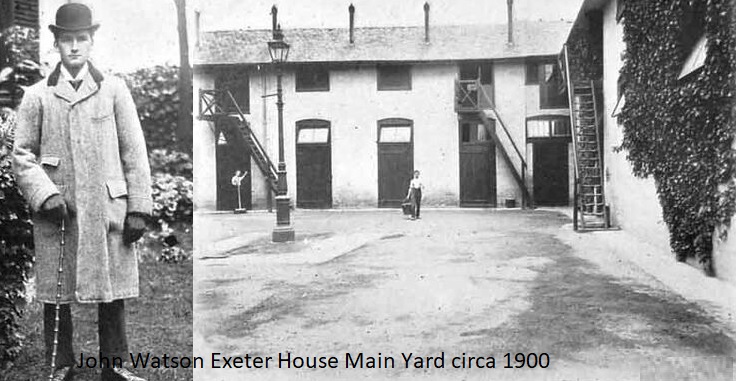
1893-1905 John Watson
John Watson, born into a racing family in 1870, was the son of James Watson, born in Northumberland in 1813, who took charge of the Nunnykirk Stud in 1830 and trained Beeswing, a mare who became pride of the North, winning the 1842 Ascot Gold Cup, the Doncaster Cup in 1837, 1840, 1841 and 1842, and the Newcastle Gold Cup every year between 1836 and 1842 except 1840. After main owner W Orde died, James moved to Bellisle, Richmond to continue training, winning the Northumberland Plate in consecutive years with First Lord in 1860 and Joey Jones in 1861. John Watson was one of a family of 11, and was born in Richmond in 1870, riding his first winner Sir John at Newcastle when trained by his Father. When he retired from race riding he embarked on a training career, starting at Exeter House Stables for Leopold de Rothschild on 1st March 1893. He went on to train for various members of the de Rothschild family for over 30 years. At Exeter House he made full use of the covered ride to ensure his horses were always race fit and ready for the start of the season. Just to prove this point he saddled the winners of the start of the season Brocklesby Stakes at Lincoln six times in a seven-year period. He won in 1896 with Jest, in 1897 with Gay Lothian, in 1898 with Amurath, 1899 with Hulcot, 1901 with Fast Castle, and in 1902 with Skyscraper. In 1898 he won the Royal Hunt Cup with Jacquemart despite carrying 8st 6lbs. At the end of the 19th century and early years of the 20th century Leopold de Rothschild split his horses between Exeter House, with John Watson, and Palace House with Alfred Hayhoe, but in 1905 John replaced Alfred at Palace House Stables. In July 1906 the Sporting Life listed all of the Newmarket Stables together with their respective trainers. John Watson was listed at Palace House, having replaced Alfred Hayhoe in 1905.
1896 Brocklesby Stakes JEST 4/1 fav owned by Leopold de Rothschild, trained by John Watson and ridden by Tommy Loates
1897 Brocklesby Stakes GAY LOTHIAN 9/4 fav owned by Leopold de Rothschild, trained by John Watson and ridden by John Watts
1898 Brocklesby Stakes AMWRATH 4/1 jt fav owned by Mr H L Raph\ael, trained by John Watson and ridden by Tommy Loates
1898 Royal Hunt Cup JACQUEMART 100/9 owned by Leopold de Rothschild, trained by John Watson and ridden by Tommy Loates
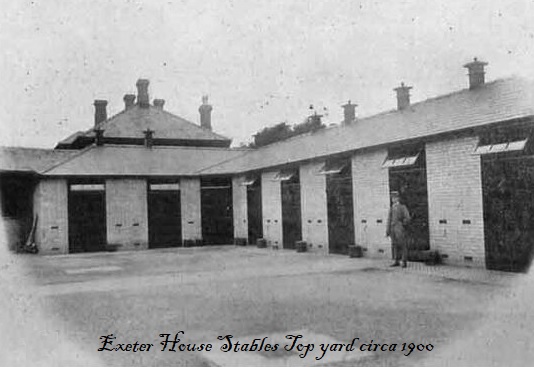
1901 Brocklesby Stakes FAST CASTLE 11/2 owned by Mr A Wagg, trained by John Watson and ridden by Kempton Cannon
1902 Brocklesby Stakes SKYSCRAPER 4/1 owned by Mr Walter Raphael, trained by John Watson and ridden by Kempton Cannon
1905-1919 Leopold de Rothschild, Alfred Hayhoe, Edouard Eloi Cunnington
Alfred Hayhoe had trained for the de Rothschild's since the death of his father, gaining an early success in the July Stakes at Newmarket in 1881 with Kermesse. Although he was not as prolific at turning out classic winners as his late father, he did train St Frusquin to land the 1896 2000 Guineas, and towards the end of his time at Palace House he guided Doricles to success in the 1901 St Leger, and St Amant to victory in the 1904 2000 Guineas and Epsom Derby. In the latter part of the 19th century Leopold de Rothschild had also made use of Exeter House Stables, installing John Watson there as his trainer. However, in 1905 Watson took charge of Palace House Stables, replacing Hayhoe. Edouard Cunnington, born 1873, brought his horses over to Newmarket in June 1915, receiving his trainer's licence that month, but felt inclined to return to France in November after training one winner at Headquarters. He took Exeter House stables, the property of Alfred Hayhoe, for that short period, starting with 3 horses but rapidly increased his string when his training talent became well know. In the 1916 census Alfred Hayoe was listed at Exeter House as retired trainer. In August 1919 Hayhoe sold Exeter House Stables to Walter Griggs. At the time it boasted the only covered circular exercise yard in Newmarket.
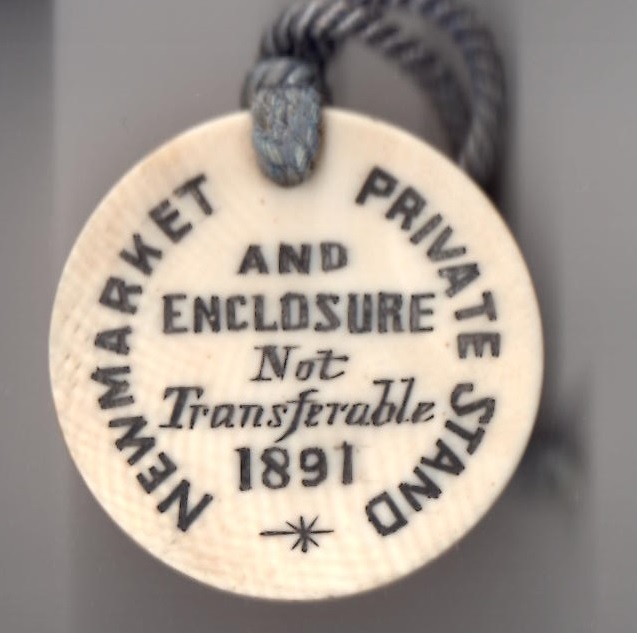
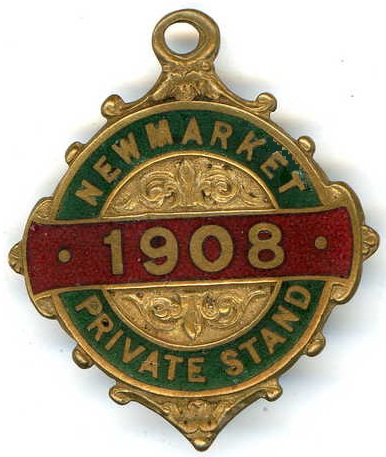
August 1919-March 1933 Walter Griggs
Walter Griggs, born in Gillingham, Kent on 13th October 1888, was the son of a Canterbury butcher who also fancied himself as a small-time bookmaker. Walter, along with his brother William, inherited his love of racing from his father, the pair taking up apprenticeships with Robert Sherwood in Newmarket. Walter gained his first win on Sotto Voce at Haydock Park on 20th May 1905, and in 1908 he won the St Leger with Jack Barnato Joel's Your Majesty (SR 1972) 11/8 fav trained by Charles Morton. The horse had already won the St James's Palace Stakes, St George's Stakes at Liverpool and the Eclipse Stakes at Sandown. The next year Walter rode Dean Swift 7/2 to victory in the Coronation Cup for the Joel/Morton combination. On 17th December 1913 Walter married Florence Rickaby, eldest daughter of Fred Rickaby, at St Agnes Church, Newmarket. He achieved his second St Leger victory in 1914 when partnering Black Jester (SR 2032) at 10/1 for Jack Joel, and in 1915 he captured another classic when Snow Marten (SR 1908) won the war-time New Oaks Stakes at Newmarket at 20/1. During the latter part of the First World War Walter served in the Royal Navy Air Service, but after the War, with his weight too heavy to continue riding, he launched his training career, taing over Saville House in 1918 on a temporary basis despite not being able to live in Saville House which was required by owner William Halsey. In August 1919 Walter purchased Exeter House Stables from Alfred Hayhoe in August 1919. During his time at Exeter House Stables he took on his two nephews, Fred and Bill Rickaby, as apprentices after their father was killed in the War in France while serving in the Royal Tank Corps. Walter nearly got his training career off to a perfect start when towards the end of the 1920 season Front Line finished runner-up to Bracket in the Cesarewitch. He always made full use of the covered ride at Essex House Stables, taking it to a new level at the start of the 1926 Flat season when he won 13 races with his first 25 runners. Although he struggled to win the most prestigious races, he did saddle Adieu to win the 1927 Ascot Gold Vase when owned by Mr F W Horlock. Walter died unexpectedly on Sunday 9th March 1933 after suffering a heart attack.
1920 Enfield Plate at Alexandra Park BUCKET 8/13 fav owned and trained by Walter Griggs and ridden by Arthur Whalley
1920 Boscawen Post Stakes at Newmarket MONARCH 4/6 fav owned by Sir Henry Bird, trained by Walter Griggs and ridden by Joe Childs
1927 Ascot Gold Vase ADIEU 100/6 owned by Mr F W Horlock, trained by Walter Griggs and ridden by Michael Beary
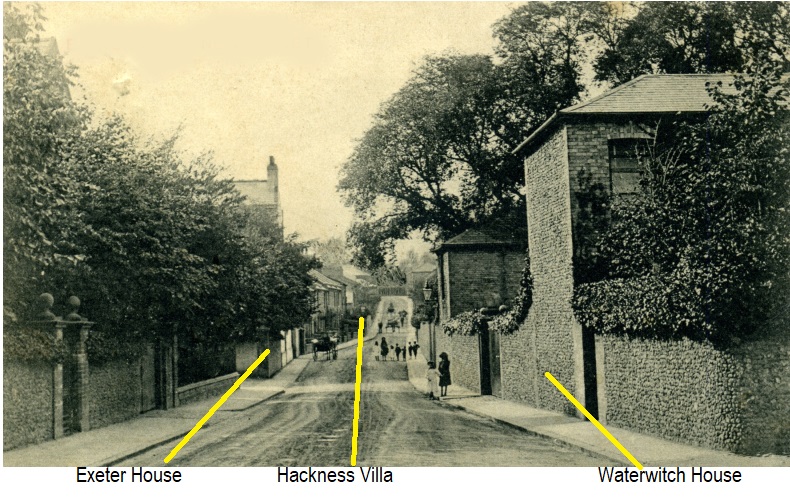
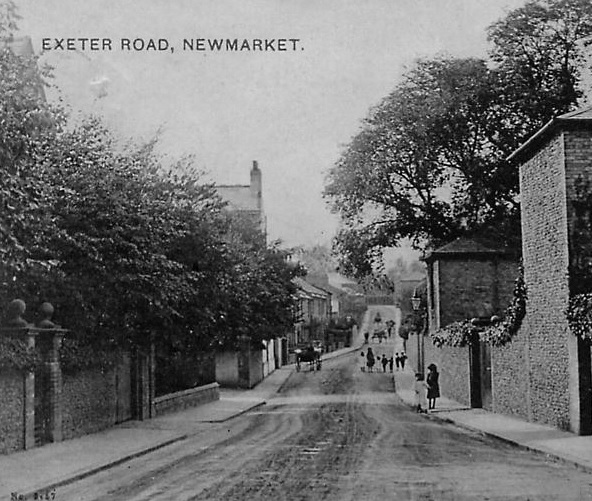
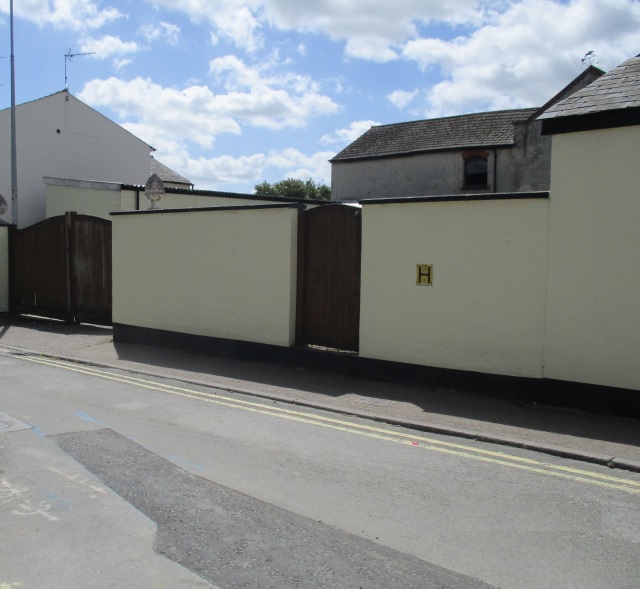
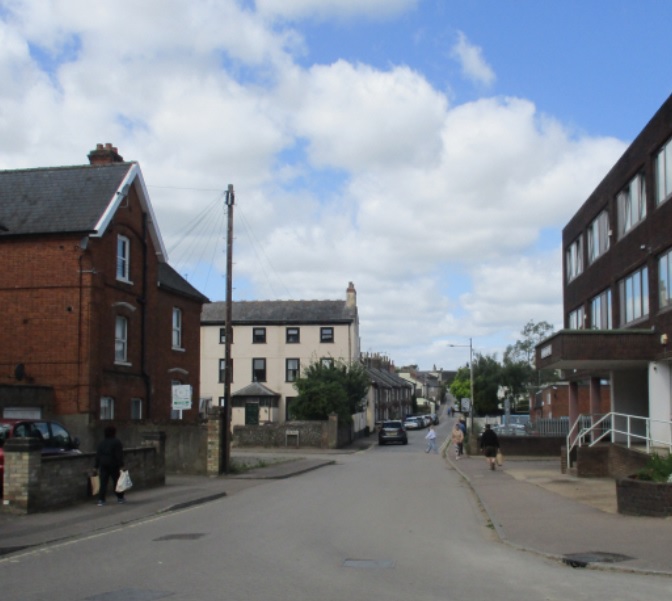
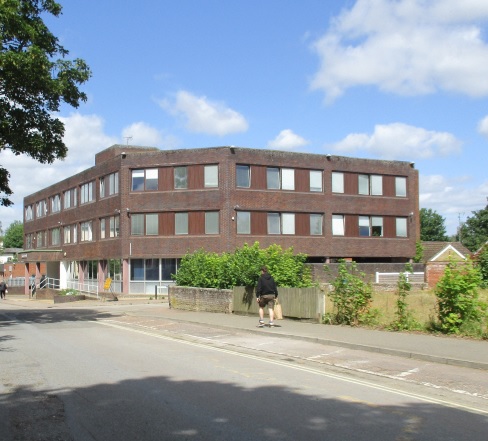
I am grateful to Tony Pringle, long-time resident of Newmarket, landlord of the Five Bells Public House for a prolonged period, and keen Newmarket historian, for the diagrams shown below and explanation of the connection between Saville House, Exeter House, Foley House and Mabille House. When William Gilbert jun moved into Saville House, Annie had Oaks Villa built, between the chapel and Saville House, probably on the back of their winnings from their 1885 Oaks victory with Lonely. However, Oaks Villa had a relatively short history as it was on the 1902 map, but had disappeared by 1926. It was Annie Gilbert who also had Plympton Villas built on the Exeter Road; 10 residences on the top edge of Saville House paddock. When the executors of Annie Gilbert put Saville House up for sale, she was also selling Mabille House (present day (2024) a Chinese takeaway) as a racing stable. The stables there at that time were used as an overspill for Saville House. Later the stable block was sold to Greene, King and reversed to face into the Five Bells public house yard rather than, as originally, towards Foley House There must have been another block facing towards the actual house, as the Five Bells only ever had stabling for 6 horses. An extension, also later acquired by Greene, King, held another 4 stables. The wall across the end of the property was big enough to accommodate around 6 more stables, but over time Mitson, the cycle shop owner, must have removed them and erected an asbestos shed where he assembled his bicycles. Tony Pringle knocked rotting roof off that extension when the brewery bought that garden, and his successor at the Five Bells knocked down the asbestos shed. By 1931 when the Pringle family took over Five Bells, the blue bits on the diagram were owned by brewers Greene, King & Sons who let it to Sid Welch (1931-1968) and his grandson Tony (1968-1991) as tenants; the red bits, including the large garden, were bought by Greene King in the 1970s, while Mabille House is shown in orange.
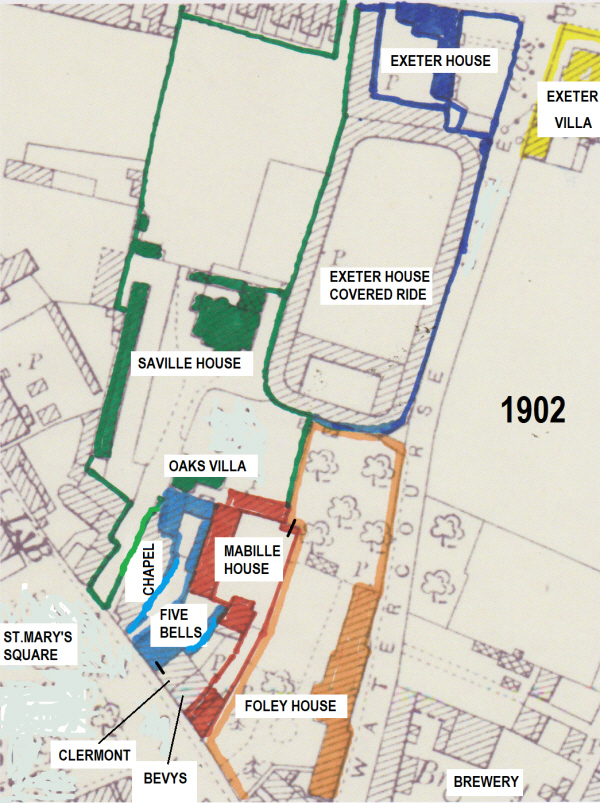
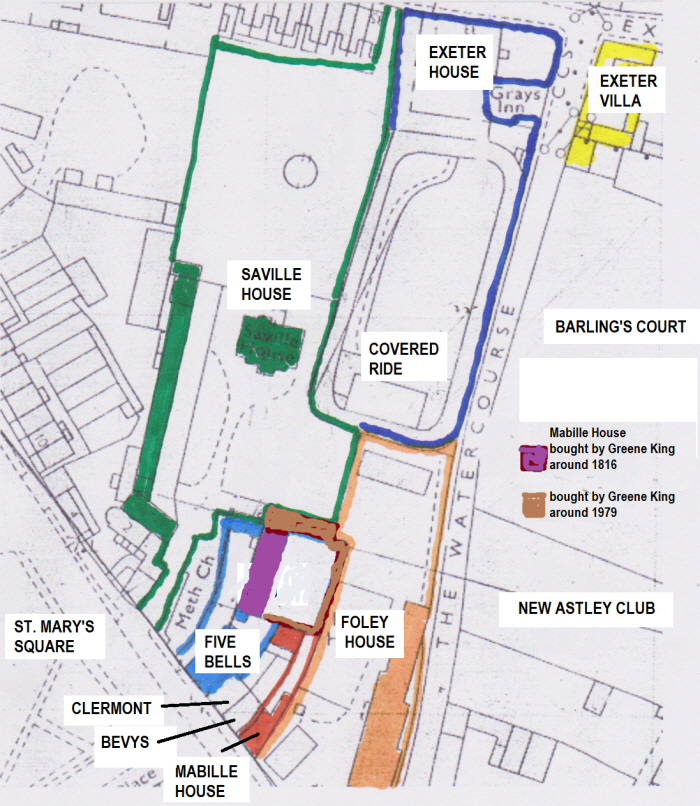
1933-54 John Upton Gaskell
After the untimely death of Walter Griggs in March 1933, his wife sold Exeter House Stables to Mr J U Gaskell who trained there for a good number of years. John Upton ('Jock') Gaskell was born on the Scottish coast at North Berwick in East Lothian on 29 January 1886 and brought up in Brighton. He was educated at Harrow. The majority of horses he trained for over 20 years at Exeter House were owned by him, and it is remarkable how many times he won the first race, so often a seller, although he won very few important races.
1935 Wellesbourne Plate at Warwick ACCIDENTAL 100/8 owned and trained by J U Gaskell and ridden by B Wilson
1935 Midland Plate at Warwick TWEEDLEDUM 7/1 owned and trained by J U Gaskell and ridden by Michael Beary
1936 Severn Plate at Chepstow TURKISH TUNIC 100/8 owned and trained by J U Gaskell and ridden by T Hawcroft
1937 Knavesmire Maiden Plate PANTRY MAN 7/1 owned and trained by J U Gaskell and ridden by T Hawcroft
1946 Holytown Plate at Hamilton Park ENGHLEN 5/2 owned and trained by J U Gaskell and ridden by W Wells
1949 Waterside Nursery Handicap at Lingfield MUSTHEARN 25/1 owned and trained by J U Gaskell and ridden by W T Evans
1951 Southam Plate at Warwick APRIL ROCK 5/2 owned and trained by J U Gaskell and ridden by R F Berry
January 1923-1960 Foley House Newmarket Grammar School
In January 1923, with 75 students on roll, Newmarket Co-educational Secondary School moved to Foley House in St Mary's Square where, in September 1923, Mr W J Watterson was appointed Head Master. There were 2 classrooms on the ground floor and 3 upstairs. However, in the Autumn Term of 1931 chaos ensued, with 2 school buildings in the mix; the Newmarket Road Council School and the Grammar School in St Mary's Square. The problem occurred when the St Mary's Square building had to be closed for a short while for repairs, but it was later deemed to be unsafe for so many students. This was a huge problem, and the Grammar School decided to try to take over the Newmarket Road buildings, offering the Newmarket Road pupils the unsafe St Mary's Square building. Clearly that solution was not accepted and the stalemate had to be solved by the Grammar School students relocating to Sussex Lodge for a year. In that year, part of Foley House was knocked down and rebuilt to make it safe and to house more students. The Grammar School students returned in 1932 and remained at Foley House until 1960. In 1959 trainer Bill O'Gorman and jockey Ian Watkinson found themselves in the same Grammar School class at Foley House, although it is uncertain whether the Maths classes covered handicapping, time and form rating systems, and how to calculate returns from Yankees and Canadians. In 1960 the school transferred to the Exning Road site.
1959-1961 Dave Thom
Dave Trenchard Thom, born on 13th July 1925 at Pollockshields on the outskirts of Glasgow, was one of 5 children. In 1941 he joined the Royal Marines to take part in the D-Day landings despite being just 16 years of age. He eventually reached the rank of Sergeant, and, once the War had ended, he fully immersed himself in the life of a racing stable, riding in point-to-point races and as a professional under National Hunt rules. His first winner was aboard Ocean Gem in a novice chase at Folkestone. David launched his training career at Exeter House in 1959, moving from there to Ellesmere House, while in 1962 he took charge at Harraton Court Stables, purchasing them from the Galpins.
1960 Coventry Handicap Chase LION'S GLEN 10/1 trained by Dave Thom and ridden by E F Kelly
1961 Wye Handicap Chase THE TUFTER 7/2 trained by Dave Thom and ridden by Tim Brookshaw
1960s Joe Whelan
At some stage in the 1960s, after Dave Thom had left for Ellesmere House and Harraton Court, trainer Joe Whelan used some of the boxes at Exeter House, although he also had boxes at Waterwitch House.
1978-98 David & Ann Dale
In 1978 David Dale, and his wife Ann, took over at Exeter House Stables. David trained for the next 15 years, after which the couple continued to live at Exeter House until 1998.
1998-99 Reginald Collier, Philip McEntee
In 1998 a wealthy American racehorse owner, Reginald Collier, decided to back the trainer Philip McEntee in his racing operation at Exeter House Stables. Tragedy then struck when Philip died unexpectedly, aged 52, in May 1998. Philip was Champion Irish Apprentice in 1966 and, after retiring from the saddle, he joined Reg Akehurst in Lambourn. Philip married Linda Doyne-Ditmas and they had 5 children, including twins Mark and Philip. Philip senior spent 10 years learning his trade from Reg, rising to become Head Lad, before becoming private trainer to Peter Freeman. He later moved to Cannock, Windsor and Beverley House Stables, Newmarket. When Philip tragically died it was Philip junior who took charge of his father's stable, later moving to Raceway Stables on the Hamilton Road.
1999-present Adult Education Centre
From 1999 to the present day, Foley House has served as an Adult Education Centre.
2003-2010 Exeter House Stables Jonathan Jay
In 2003 Jonathan Jay took over at Exeter House Stables and enjoyed success in the early years. However, in March 2010 his licence was temporarily withdrawn by the BHA, although it was returned a month later when an outstanding debt had been settled. Then, in July 2010 Jonathan Jay left Exeter House Stables
February 2011-present Exeter House Stables Charlie McBride
In February 2011 Charlie McBride, with the support of his wife Bev and son Sam, moved from the Hamilton Road stables he leased, buying the 17-box Exeter House Stables from the bank after they repossessed the racing establishment from Jonathan Jay. Charlie began working in the racing industry as an apprentice with Jack Clayton before moving on to Bruce Hobbs at Palace House Stables. In 1985 he was appointed Head Lad to Lord John Fitzgerald at Albert House Stables, after which he was ready to take out his own licence and launch his training career. Three years later be became assistant trainer to Conrad Allen, later gaining further experience with Willie Musson. Since 2011 he has developed and improved Exeter House Stables.
STOCKWELL (1852 2000 Guineas, St Leger)
ST GATIEN (1884 Epsom Derby, Cesarewitch)
GALATA (1832 1000 Guineas, Epsom Oaks, 1833 Ascot Gold Cup)
AUGUSTA (1821 Epsom Oaks)
INTERPRETER (1818 2000 Guineas)



